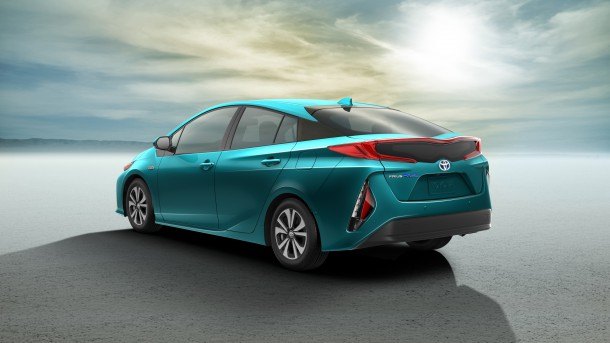NYIAS: 2017 Toyota Prius Prime - Eco-Warrior Goes Posh
In the nearly 20 years it’s been on the market, the Toyota Prius has become an icon of eco-friendly motoring. Now, Toyota wants to build on the legend with a new, more upmarket version called Prius Prime. It comes equipped with plug-in charging, but it should be much more than the previous-generation Prius Plug-In. While the Plug-In was basically nothing more than a basic Prius with a larger battery and electric plug, the Prime is supposed to add style and luxury.
From the outside, it’s still evident that the Prime is built on the same bones as the standard Prius, with identical exterior dimensions and similar basic lines, but the details are noticeably different. The front end is much more aggressive, with a blacked-out “grille” area, segmented headlights and teardrop-shaped running and fog lights in the bumper.
In the rear, the huge taillight forms a shape similar to the one on the current generation Charger. Toyota is eager to point out that the new car is no “aero jellybean.” Instead, the car is said to be “daring the wind to stay in its way.”
Overall, the Prime continues in the aggressive direction set up by the 2016 Prius and takes it one step further. Whether this “muscle hybrid” approach will sit well with the traditional Prius customers remains to be seen.
It’s not all just about looks. The Prime receives a new, 8.8 kWh battery pack. That’s twice the size of its predecessor, doubling the range in fully electric mode to 22 miles. According to Toyota, this should be enough to cover the daily commuting needs of more than a half of U.S. drivers. Recharging the batteries will take 5.5 hours via a standard household outlet, or less than half the time from a 240V plug.
Another difference in comparison with the previous generation, or any other hybrid Toyota for that matter, is that the Prius Prime uses a dual-motor drive system where the generator can be used to provide the driving force as well as the main electric motor. This helps the Prius Prime to achieve more agility in full electric mode, moving its electric top speed to 84 miles per hour, and allows it to spend more time in electric drive, even if driving in standard hybrid mode.
The other part of the Toyota’s Hybrid Synergy Drive is once again a 1.8-liter four-cylinder engine, known from the standard Prius. It’s an Atkinson cycle mill like the standard Prius engine and provides 40-percent thermal efficiency.
The whole drivetrain is said to achieve 120 miles-per-gallon-equivalent in electric mode, whatever that means for real-world consumption. More importantly, the real mpg figures remain the same or slightly better compared with the standard car (54/50 mpg).
Inside, the focal point is the new 11.6-inch infotainment screen with advanced smartphone connection. You can now control the car’s AC from a smartphone, manage its charging schedule, find charging stations, and — of course — compare your eco-driving score with others on social media. The last feature will be undoubtedly loved by everyone driving behind the heroic eco-warriors trying to out-do their Facebook friends.
More by Vojta Dobe
Latest Car Reviews
Read moreLatest Product Reviews
Read moreRecent Comments
- W Conrad I'm not afraid of them, but they aren't needed for everyone or everywhere. Long haul and highway driving sure, but in the city, nope.
- Jalop1991 In a manner similar to PHEV being the correct answer, I declare RPVs to be the correct answer here.We're doing it with certain aircraft; why not with cars on the ground, using hardware and tools like Telsa's "FSD" or GM's "SuperCruise" as the base?Take the local Uber driver out of the car, and put him in a professional centralized environment from where he drives me around. The system and the individual car can have awareness as well as gates, but he's responsible for the driving.Put the tech into my car, and let me buy it as needed. I need someone else to drive me home; hit the button and voila, I've hired a driver for the moment. I don't want to drive 11 hours to my vacation spot; hire the remote pilot for that. When I get there, I have my car and he's still at his normal location, piloting cars for other people.The system would allow for driver rest period, like what's required for truckers, so I might end up with multiple people driving me to the coast. I don't care. And they don't have to be physically with me, therefore they can be way cheaper.Charge taxi-type per-mile rates. For long drives, offer per-trip rates. Offer subscriptions, including miles/hours. Whatever.(And for grins, dress the remote pilots all as Johnnie.)Start this out with big rigs. Take the trucker away from the long haul driving, and let him be there for emergencies and the short haul parts of the trip.And in a manner similar to PHEVs being discredited, I fully expect to be razzed for this brilliant idea (not unlike how Alan Kay wasn't recognized until many many years later for his Dynabook vision).
- B-BodyBuick84 Not afraid of AV's as I highly doubt they will ever be %100 viable for our roads. Stop-and-go downtown city or rush hour highway traffic? I can see that, but otherwise there's simply too many variables. Bad weather conditions, faded road lines or markings, reflective surfaces with glare, etc. There's also the issue of cultural norms. About a decade ago there was actually an online test called 'The Morality Machine' one could do online where you were in control of an AV and choose what action to take when a crash was inevitable. I think something like 2.5 million people across the world participated? For example, do you hit and most likely kill the elderly couple strolling across the crosswalk or crash the vehicle into a cement barrier and almost certainly cause the death of the vehicle occupants? What if it's a parent and child? In N. America 98% of people choose to hit the elderly couple and save themselves while in Asia, the exact opposite happened where 98% choose to hit the parent and child. Why? Cultural differences. Asia puts a lot of emphasis on respecting their elderly while N. America has a culture of 'save/ protect the children'. Are these AV's going to respect that culture? Is a VW Jetta or Buick Envision AV going to have different programming depending on whether it's sold in Canada or Taiwan? how's that going to effect legislation and legal battles when a crash inevitibly does happen? These are the true barriers to mass AV adoption, and in the 10 years since that test came out, there has been zero answers or progress on this matter. So no, I'm not afraid of AV's simply because with the exception of a few specific situations, most avenues are going to prove to be a dead-end for automakers.
- Mike Bradley Autonomous cars were developed in Silicon Valley. For new products there, the standard business plan is to put a barely-functioning product on the market right away and wait for the early-adopter customers to find the flaws. That's exactly what's happened. Detroit's plan is pretty much the opposite, but Detroit isn't developing this product. That's why dealers, for instance, haven't been trained in the cars.
- Dartman https://apnews.com/article/artificial-intelligence-fighter-jets-air-force-6a1100c96a73ca9b7f41cbd6a2753fdaAutonomous/Ai is here now. The question is implementation and acceptance.



































Comments
Join the conversation
The new Prius is horrifying in photos, but actually very attractive in person. I dated someone like that once.
When do we get a Prius Sport? Seriously. If Toyota put some effort into making a Prius that autocrossed well and looked a little more sporting, I think they'd sell the crap out of them. I commute just a little more than 22 miles to work and home. I'd be interested.